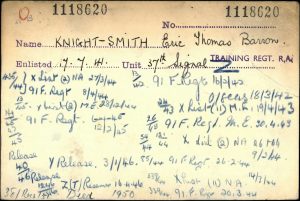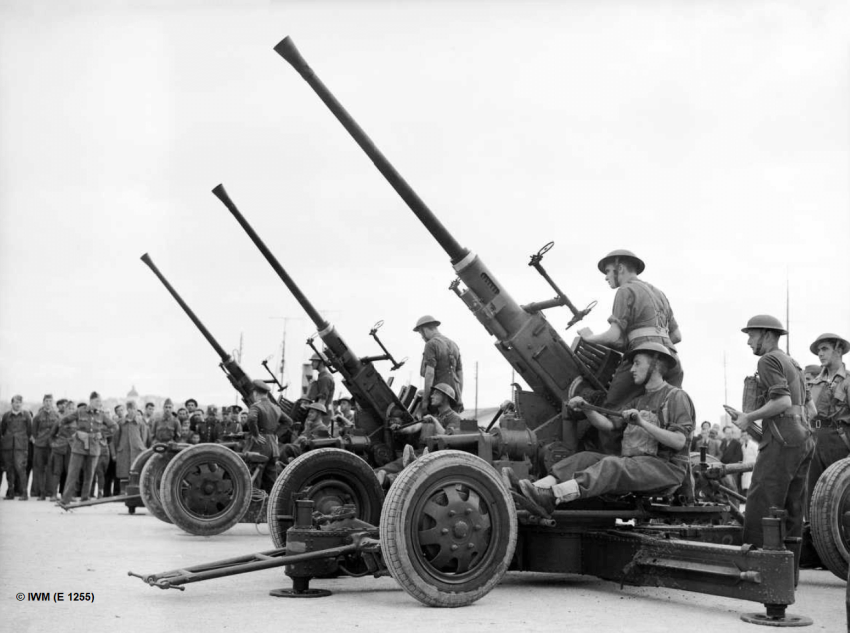Our UK, WWII, Royal Artillery Tracer Cards, 1939-1948 collection is a must for anyone wishing to piece together the movements of an ancestor who served with the Royal Artillery during WWII. The Royal Artillery was crucial to Britain’s war effort during WWII. Made up of 960 gunner regiments, at its peak, over one million men served with the unit during the war; perhaps your ancestor was one of them?
What is a tracer card?
The collection comprises ‘tracer cards’ created to track the movements of soldiers between regiments of the Royal Artillery during WWII. Their primary function was to pinpoint a soldier’s location quickly and efficiently without the need to wade through multiple files or paperwork. The cards were a useful administrative tool, helping to keep track of scores of men during a period of fast-moving global conflict.
How can they help me with my research?
You may know that an ancestor serving with the Royal Artillery was evacuated from Dunkirk or took part in the D-Day landings. Perhaps you have heard stories about your father or grandfather who was wounded, commended for bravery or even taken prisoner during the war serving with the artillery. But how do you build on these clues and add further context to the events in question?
Service records are undoubtedly the most valuable source when researching an ancestor who served in the military. However, you may not have your ancestor’s service record, or you may be carrying out a local research project, and it’s not feasible to order dozens of service records from the Ministry of Defence or The National Archives.
This is where the tracer cards fill in the gaps left by the absence of a service record. The cards contain chronological references to the different regiments of the artillery that your ancestor served with, allowing you to plot their movements throughout the war. Now, you can confirm that the ancestor present at Dunkirk served with the 91st Field Regiment, or the great-uncle you have heard so much about, who landed at Normandy in June 1944, was part of the 102nd Light Anti-Aircraft Regiment.
FWR Tip: The cards often provide an enlistment date, allowing you to pinpoint when your ancestor’s service began. Their army number, generally recorded, provides a valuable clue, enabling you to search other military collections.
Let’s take a look at how to read the cards.
Deciphering tracer cards
Here are some tips for deciphering the cards based on the entry for Eric Thomas Barron Knight-Smith.

Eric enlisted on 17 July 1941 and was posted to the 37th Signal Training Regiment, Royal Artillery. His army number, typed at the top of the card, was 1118620.
To establish the different units the soldier served with:
- Start with the right-hand column.
- Begin at the top and work your way down to the bottom.
- Move on to the top of the left-hand column and, once more, work your way down.
Below is an interpretation of Eric’s tracer card (in most instances, we have recorded abbreviated terms in full):
- 91st Field Regiment – 16 February 1942
- Overseas – 18 March 1942
- X List(II) ME [Middle East] – 19 April 1943
- 91st Field Regiment Middle East – 30 April 1943
- X List(2) NA [North Africa] – 26 January 1944 [to] 9 February 1944
- 91st Field Regiment – 26 February 1944
- X List(II) North Africa – 14 March 1944
- 91st Field Regiment – 20 March 1944
- X List(2)North Africa – 27 March 1944
- 91st Field Regiment – 8 April 1944
- X List(2) Middle East – 28 December 1944
- 91st Field Regiment – 12 February 1945
- Y Release – 3 January 1946
- Z(T) Reserve – 16 April 1946
- Died – 1950
The numbers often found to the left of the unit and date, such as 24/43, are not units within the Royal Artillery but relate to regimental orders concerning the movement.
You may encounter references to the X and Y Lists, as noted on the card above (they often appear in service records too). These generally relate to instances where a soldier was away from their unit, perhaps as a result of wounds, sickness or hospitalisation. X relates to instances overseas, and Y generally refers to the United Kingdom. For example:
X List(II)/X List(2) relates to hospitalisation due to wounds or sickness.
You may have to search online for descriptions of the various X and Y list references.
Considerations
The tracer cards concern other ranks only and do not include commissioned officers of the Royal Artillery.
Often, a card was destroyed if the soldier died in service, as the purpose of the cards was to pinpoint the individual’s location.
Only one of two cards will occasionally exist; if the person’s details span two cards, the first card was sometimes discarded.
Further research
Once you have established the different units of the Royal Artillery that your ancestors served with, you can turn your attention to other sources, such as war diaries, prisoner of war records or casualty collections. These can help you to build on your discoveries made in the tracer cards and add colour and context to your ancestor’s service.
Ultimately, we all want to paint as vivid a picture as possible of our ancestors’ wartime service and try to understand their experiences as best as we can. The Royal Artillery tracer cards can start you on your research journey, and when used in conjunction with other sources, they can lead to significant discoveries.
There are many collections available on Forces War Records to help you research your ancestors’ military service. You can view all our records via the Browse tab, with options available to narrow the collections by country, theatre of war or service branch.
We’re always here for you if you need help or advice with your research. Why not follow us on Facebook and submit a question to one of our monthly military genealogy Q&As? You can also send a query via the Document Expert section of our website.
Cover image: © IWM (E 1255)
Sources:
National Army Museum, Royal Artillery, accessed August 2023.
The Royal Artillery Museum.


